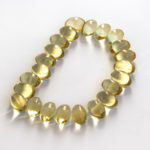
Vitamin D
Getting the right amount of vitamins is an important part of a healthy lifestyle. Ideally, getting vitamins through the food we eat is the best way for our bodies to receive nutrition. When that fails, supplements can be a good source of nutrition. Unfortunately, many people tend to treat supplements less seriously than medicine and often take larger doses than necessary. Vitamin D is easy to over-ingest. Often, Vitamin D is found in daily supplements AND in calcium supplements, and many people, especially women, can take too much. Conversely, with decreasing outdoor activity and increased sunscreen usage, many people are diagnosed with Vitamin D deficiency.
Taking too much Vitamin D, or Vitamin D toxicity, is a problem. Vitamin D toxicity usually occurs from an overdose of supplements, not through sun exposure or though food. Our bodies regulate the amount of vitamin D from sun exposure, and foods. Even foods fortified with Vitamin D don’t contain large amounts of the vitamin. Various supplements can cause a build-up of calcium in the blood, called “hypercalcemia.” This causes poor appetite, nausea and vomiting, frequent urination and kidney problems. Your physician can test your blood to make sure your Vitamin D levels are within a healthy range.
As for a deficiency of this important vitamin, it typically occurs at a higher rate for: people who live in northern areas, (imagine a line drawn from San Francisco to Philadelphia and the folks who live north of that line), people with dark skin, older individuals, and people who are overweight. People without enough Vitamin D tend to face problems like rickets, a bone-weakening disease; osteoporosis, some cancers, and even heart disease.
Check your supplements and total your Vitamin D amounts to ensure the proper dosage. Also, if you have liver or kidney conditions or take thiazide-type diuretics, talk to your doctor about your vitamin regimen.
How much Vitamin D do I need and how should I get it?
The recommended Daily Allowance is 600 IU for adults. Getting outside for 15 minutes in the sun is a great way to get Vitamin D. It sounds obvious, but you should not wear sunscreen during this time, to let your skin absorb the Vitamin D. If possible, have skin on your arms and legs exposed.
Many foods provide a good source of Vitamin D. Consider adding some of these grocery items into your diet: beef or calf liver, egg yolks, wild caught fish, shitake mushrooms, milk, oatmeal, and Vitamin D fortified cold cereals.
As with many health issues, the best option for Vitamin D intake lies in the middle-ground—get your Vitamin D through both sun exposure and whole foods, and watch the amount you receive from supplements.





